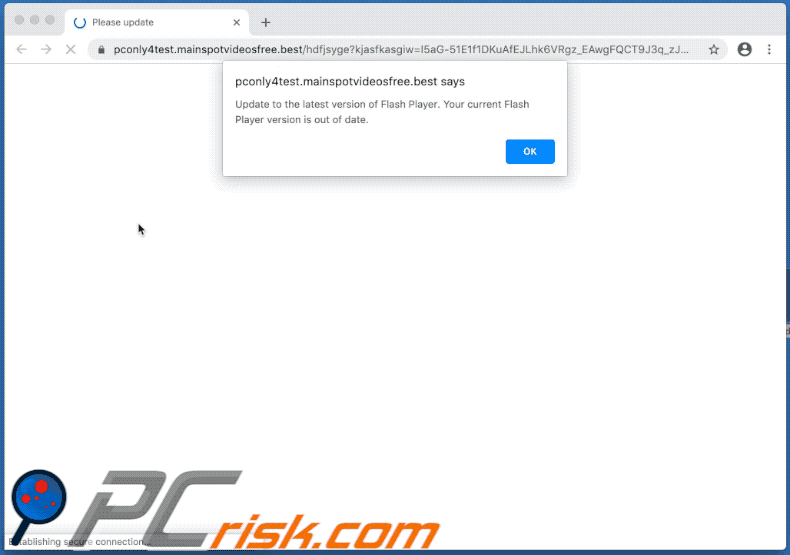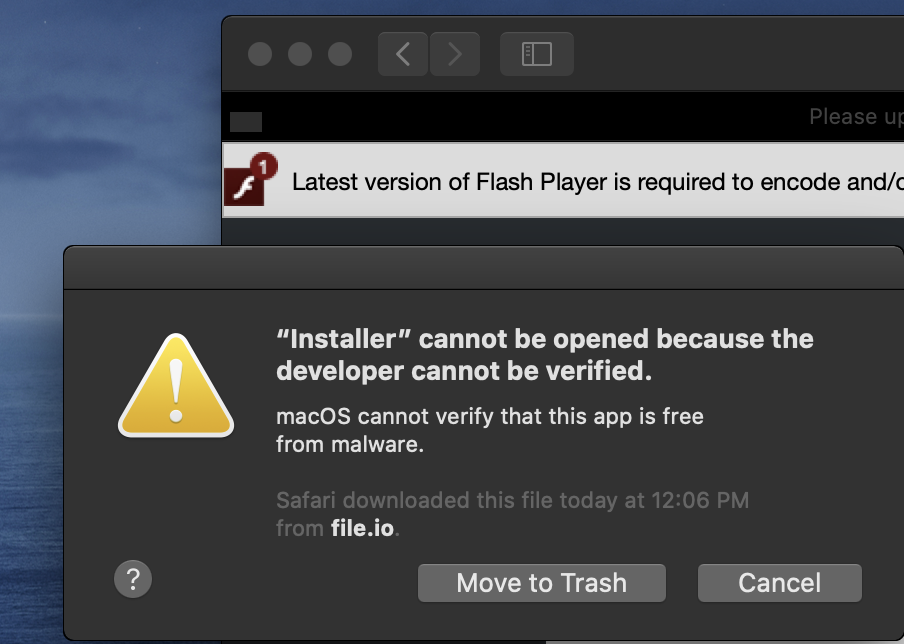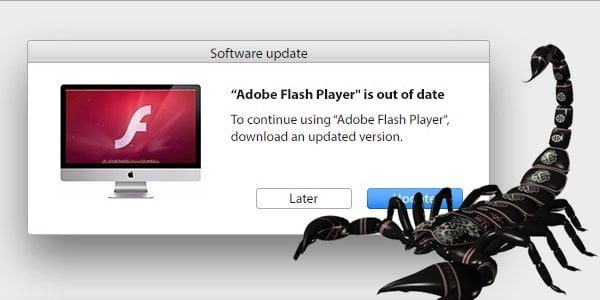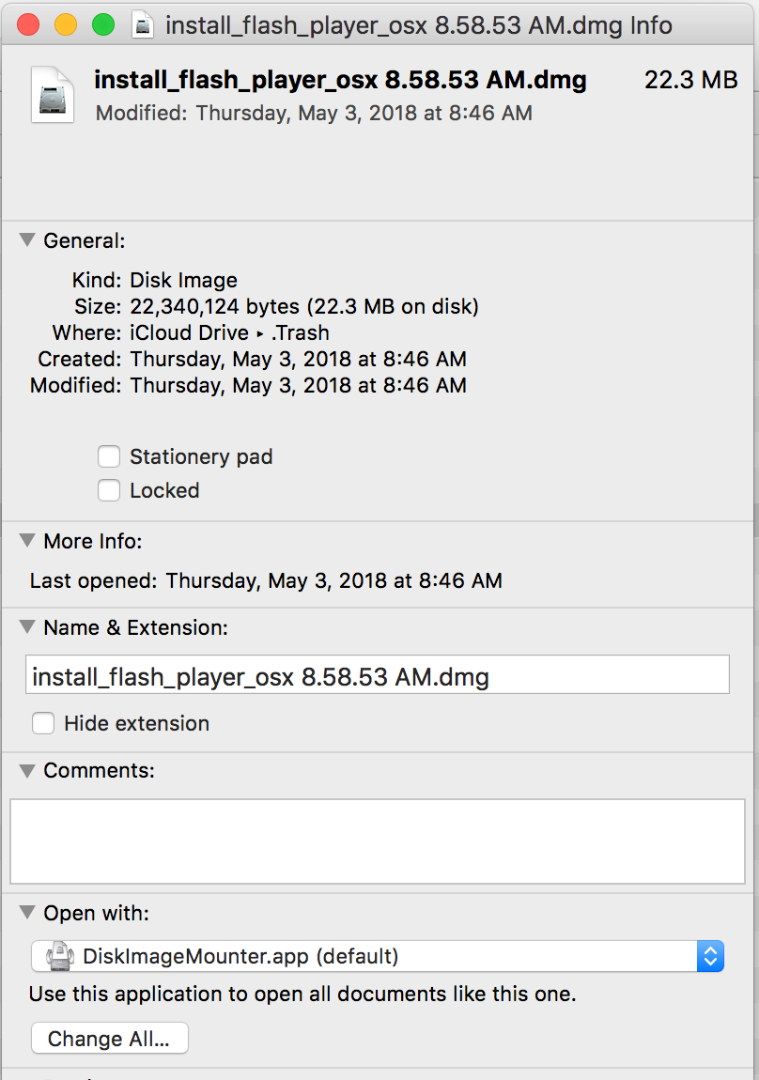Mac Flash Download Dmg File Moved Virus
“Adobe Flash Player is out of date” pop-up message should never be trusted, as its primary goal is to make users download and install adware or malware like Trojan.BitcoinMiner. Adobe Flash Player is out of date scam is only one of many examples of the virus seeking to scare users into downloading a fake update. Use Garmin Express to update maps and software, sync with Garmin Connect™ and register your device. This desktop software notifies you when updates are available and helps you install them. Mac Flashback malware: What it is and how to get rid of it (FAQ) The Flashback Trojan is the latest malware attack to target Apple's Mac platform. Here's your guide to what it is, whether you have.
How to remove 'Adobe Flash Player' is out of date' from Mac computers
What is 'Adobe Flash Player' is out of date'?
When opened, this deceptive website displays a pop-up window suggesting that the installed version of Adobe Flash Player is out of date and encourages users to download and install the latest version. At the time of research, this page downloaded an installer of two applications: Media Player and MyCouponsmart. Like most websites of this type, this page is designed to trick people into installing potentially unwanted applications (PUAs). In most cases, these sites distribute PUAs such as browser hijackers and adware, however, some attempt to trick visitors into installing Trojans, ransomware and other high-risk malware.
According to this website, the installed version of Adobe Flash Player does not include the latest security updates and cannot be used unless it is updated. It downloads a file called 'Adobe Flash Player.dmg', which is supposedly designed to install the latest Adobe Flash Player, however, rather than installing any legitimate software it installs Media Player and MyCouponsmart. Note that MyCouponsmart is adware that serves intrusive ads including coupons, banners, surveys, pop-ups, and so on. These conceal underlying content of visited pages and, if clicked, open potentially malicious pages or download and install unwanted software. Furthermore, adware can record browsing-related information such as IP addresses, geolocations, addresses of visited pages, entered search queries, and other browsing data. In some cases, this software collects private, sensitive details. The people responsible for these apps misuse gathered data to generate revenue, or they sell it to third parties (potentially, cyber criminals). Note that another app that is included with this fake Adobe Flash Player installer might operate as adware. In some cases, fake installers are used to infect systems with malware such as a Trojans, ransomware or other malicious software. People with computers infected with programs of this kind usually experience data and financial loss, problems with browsing safety, privacy, and risk becoming victims of identity theft. Therefore, software should never be downloaded from any scam websites.

| Name | 'Adobe Flash Player' is out of date pop-up |
| Threat Type | Phishing, Scam, Mac malware, Mac virus. |
| Fake Claim | According to this website, the installed version of Adobe Flash Player is out of date. |
| Detection Names (Adobe Flash Player.dmg) | Avast (MacOS:Agent-FJ [Adw]), AVG (MacOS:Agent-FJ [Adw]), DrWeb (Adware.Mac.Bundlore.775), Kaspersky (Not-a-virus:HEUR:AdWare.OSX.Bnodlero.ah), Full List (VirusTotal) |
| Promoted Unwanted Application | Media Player, MyCouponsmart |
| Symptoms | Your Mac becomes slower than normal, you see unwanted pop-up ads, you are redirected to dubious websites. |
| Distribution methods | Deceptive pop-up ads, free software installers (bundling), fake Flash Player installers, torrent file downloads. |
| Damage | Internet browser tracking (potential privacy issues), display of unwanted ads, redirects to dubious websites, loss of private information. |
| Malware Removal (Mac) | To eliminate possible malware infections, scan your Mac with legitimate antivirus software. Our security researchers recommend using Combo Cleaner. |
Other examples of similar scam websites include operatedevelopeduberprogram[.]icu, operateuberrefinedprogram[.]icu and mainspotupdatesfreenew[.]info. Typically, they deceive visitors into using fake Adobe Flash Player installers by suggesting that the installed version of this software is outdated. These installers do not provide the official Adobe Flash Player software - they install PUAs or other malicious software. Websites of this type are often opened by PUAs that are already installed on browsers and/or operating systems.
How did potentially unwanted applications install on my computer?
People often download and install PUAs unintentionally when they are included into the download/installation set-ups of other (mainly free) software. Information about these additional downloads/installations can be found in settings such as 'Custom', 'Advanced', 'Manual', etc. When software is downloaded or installed without checking and changing these settings, PUAs receive permission to be downloaded and installed. This PUA distribution method is known as 'bundling' and is used by developers to trick people into downloading and installing unwanted apps with other, regular software. In other cases, PUAs are downloaded and installed when people click deceptive ads that run certain scripts.
How to avoid installation of potentially unwanted applications
Unwanted downloads and installations can be avoided by downloading software only from official websites. Avoid third party downloaders, installers, Peer-to-Peer networks (e.g., torrent clients, eMule), dubious websites and other similar channels. Check 'Custom', 'Advanced' and other similar settings of the download/installation setup and dismiss offers to download or install additionally-included software. Do not click intrusive ads that appear on dubious web pages - they often cause redirects to untrusted and potentially malicious websites or download/installation of PUAs. Remove any unwanted, suspicious applications (extensions, plug-ins, add-ons) already installed on the browser immediately. The same should be applied to software that is installed on the operating system. If your computer is already infected with PUAs, we recommend running a scan with Combo Cleaner Antivirus for macOS to automatically eliminate them.
Appearance of 'Adobe Flash Player' is out of date' scam (GIF):
Text in a pop-up window:
Latest version of Player is recommended to encode and/or decode (play) audio files in high quality - click here to update for latest version.
'Adobe Flash Player' is out of date
The version of 'Adobe Flash Player' on your system does not include the latest flash update and has been blocked. To continue using 'Adobe Flash Player', download an update version.

The download process will be performed by launching mediadownloader, which is a platform for the installation of software ('Installer'). The Installer may include suggestions for the installation of additional free software offers ('Offers'), alongside the installation. You may choose to install the offers during the installation process. You may also remove the offers after you have chosen to install them. IP address will be logged for analytics and fraud detection reasons and will be deleted from our records after 24 hours. You can download without using the Installer from its original site. Your use of the Installer is subject to the Installer's Terms of Use & Privacy Policy. Uninstall
Fake Adobe Flash Player installer:
Another screenshot of fake Adobe Flash Player installer:
Instant automatic Mac malware removal:Manual threat removal might be a lengthy and complicated process that requires advanced computer skills. Combo Cleaner is a professional automatic malware removal tool that is recommended to get rid of Mac malware. Download it by clicking the button below:
▼ DOWNLOAD Combo Cleaner for MacBy downloading any software listed on this website you agree to our Privacy Policy and Terms of Use. To use full-featured product, you have to purchase a license for Combo Cleaner. Limited three days free trial available.
Quick menu:
- STEP 1. Remove PUA related files and folders from OSX.
- STEP 2. Remove rogue extensions from Safari.
- STEP 3. Remove rogue add-ons from Google Chrome.
- STEP 4. Remove potentially unwanted plug-ins from Mozilla Firefox.
Video showing how to remove adware and browser hijackers from a Mac computer:
Potentially unwanted applications removal:
Remove potentially unwanted applications from your 'Applications' folder:
Click the Finder icon. In the Finder window, select 'Applications'. In the applications folder, look for 'MPlayerX', 'NicePlayer', or other suspicious applications and drag them to the Trash. After removing the potentially unwanted application(s) that cause online ads, scan your Mac for any remaining unwanted components.
Combo Cleaner checks if your computer is infected with malware. To use full-featured product, you have to purchase a license for Combo Cleaner. Limited three days free trial available.
Remove 'adobe flash player' is out of date pop-up related files and folders:
Click the Finder icon, from the menu bar. Choose Go, and click Go to Folder...
Check for adware-generated files in the /Library/LaunchAgents folder:
In the Go to Folder... bar, type: /Library/LaunchAgents
In the “LaunchAgents” folder, look for any recently-added suspicious files and move them to the Trash. Examples of files generated by adware - “installmac.AppRemoval.plist”, “myppes.download.plist”, “mykotlerino.ltvbit.plist”, “kuklorest.update.plist”, etc. Adware commonly installs several files with the same string.
Check for adware generated files in the /Library/Application Support folder:
In the Go to Folder... bar, type: /Library/Application Support
In the “Application Support” folder, look for any recently-added suspicious folders. For example, “MplayerX” or “NicePlayer”, and move these folders to the Trash.
Check for adware-generated files in the ~/Library/LaunchAgents folder:
In the Go to Folder bar, type: ~/Library/LaunchAgents
In the “LaunchAgents” folder, look for any recently-added suspicious files and move them to the Trash. Examples of files generated by adware - “installmac.AppRemoval.plist”, “myppes.download.plist”, “mykotlerino.ltvbit.plist”, “kuklorest.update.plist”, etc. Adware commonly installs several files with the same string.
Check for adware-generated files in the /Library/LaunchDaemons folder:
In the Go to Folder... bar, type: /Library/LaunchDaemons
In the “LaunchDaemons” folder, look for recently-added suspicious files. For example “com.aoudad.net-preferences.plist”, “com.myppes.net-preferences.plist”, 'com.kuklorest.net-preferences.plist”, “com.avickUpd.plist”, etc., and move them to the Trash.
Scan your Mac with Combo Cleaner:
If you have followed all the steps in the correct order you Mac should be clean of infections. To be sure your system is not infected run a scan with Combo Cleaner Antivirus. Download it HERE. After downloading the file double click combocleaner.dmg installer, in the opened window drag and drop Combo Cleaner icon on top of the Applications icon. Now open your launchpad and click on the Combo Cleaner icon. Wait until Combo Cleaner updates it's virus definition database and click 'Start Combo Scan' button.
Combo Cleaner will scan your Mac for malware infections. If the antivirus scan displays 'no threats found' - this means that you can continue with the removal guide, otherwise it's recommended to remove any found infections before continuing.

After removing files and folders generated by the adware, continue to remove rogue extensions from your Internet browsers.
'Adobe Flash Player' is out of date pop-up removal from Internet browsers:
Remove malicious extensions from Safari:
Remove 'adobe flash player' is out of date pop-up related Safari extensions:
Open Safari browser, from the menu bar, select 'Safari' and click 'Preferences...'.

In the preferences window, select 'Extensions' and look for any recently-installed suspicious extensions. When located, click the 'Uninstall' button next to it/them. Note that you can safely uninstall all extensions from your Safari browser - none are crucial for normal browser operation.
- If you continue to have problems with browser redirects and unwanted advertisements - Reset Safari.
Remove malicious plug-ins from Mozilla Firefox:
Remove 'adobe flash player' is out of date pop-up related Mozilla Firefox add-ons:
Open your Mozilla Firefox browser. At the top right corner of the screen, click the 'Open Menu' (three horizontal lines) button. From the opened menu, choose 'Add-ons'.
Choose the 'Extensions' tab and look for any recently-installed suspicious add-ons. When located, click the 'Remove' button next to it/them. Note that you can safely uninstall all extensions from your Mozilla Firefox browser - none are crucial for normal browser operation.
- If you continue to have problems with browser redirects and unwanted advertisements - Reset Mozilla Firefox.
Remove malicious extensions from Google Chrome:
Remove 'adobe flash player' is out of date pop-up related Google Chrome add-ons:
Open Google Chrome and click the 'Chrome menu' (three horizontal lines) button located in the top-right corner of the browser window. From the drop-down menu, choose 'More Tools' and select 'Extensions'.
In the 'Extensions' window, look for any recently-installed suspicious add-ons. When located, click the 'Trash' button next to it/them. Note that you can safely uninstall all extensions from your Google Chrome browser - none are crucial for normal browser operation.
- If you continue to have problems with browser redirects and unwanted advertisements - Reset Google Chrome.
A .DMG file is a container file commonly used to distribute applications for Mac OS X. Installing software from one of these requires you to mount the image and move its contents to your computer’s “Applications” directory.
Os X Dmg File Download
One of the most common mistakes I see among new Mac users is fumbling with how to install and open .dmg files or new software. The process for installing new applications on your Mac can be confusing at first because it differs greatly from Windows’ software installation process. Nevertheless, the Mac method of installing software is actually quite simple and intuitive once you are accustomed to it. If your desktop is littered with DMG files and white “drive”-looking icons, read on!
Contents
What are .DMG Files?
DMG stands for Disk Image, and is a format commonly used to distribute files and applications among Apple computers. A DMG file is like a virtual DVD or hard drive. They can be “mounted” on your Mac in order to work with their contents, or even burned to an actual physical disc.
In order to understand the concept of a DMG disk image, think of a storage volume such as a CD, DVD, hard drive, or external drive. A DMG file is like one of these devices in that it serves as a means to encapsulate documents, images, software, and other files. The difference is that with a DMG, there is no physical storage medium. There is only the DMG file, which can be written to a hard drive, burned to a CD or DVD, or sent over the Internet.
In order to work with the contents of a DMG file, you must mount the the disk image to your system. This may sound daunting, however “mounting” a DMG file with Mac OS X is no more complicated than double-clicking it’ icon. The operating system will load the load image and place a new icon both on your desktop, and in the sidebar of the Finder. The icon will have the same name as the DMG, and you’ll be able to browse through its contents like any other folder.
Once you are done working with the contents of the file, you will want to remove or “unmount” it from your system. Do this by opening the Finder and clicking the eject icon next to the virtual drive’s icon. Or, go to the Desktop, click once on the icon, and press CMD+E.
Also Useful:Best Gaming Laptops Under $2000
How to Install and Open .dmg Files on a Mac
Software installation with Mac OS X is very different than in the Windows world. On a Windows PC you run an installer, tick off a few checkboxes, and wait for the progress meter to reach completion. There usually is no such “installation wizard” on a Mac &emdash; you simply drag and drop the program into your computer’s “Applications” directory. The trick is that most Mac applications are distributed as images called DMG files, and many new Mac users end up running applications directly from the image instead of installing them to the “Applications” directory.
Enough explanation, here’s how to install an OS X app from a DMG file:
- Find the downloaded file, which usually ends up in your Desktop or Downloads folder.
- Double-click the .DMG file to mount it. A new Finder window showing its contents should appear.
- If the window also contains a shortcut icon to “Applications”, drag and drop the app onto the shortcut.
- If not, double-click the mounted volume on your desktop and drag the app icon from there to the “Applications” icon in the Finder sidebar.
Further Explanation
Alright, that was the abridged version. Here’s the long version. I’ve just downloaded the DeskLickr application, and the DeskLickr_1.2.dmg is sitting on my desktop. I double-click it and a new icon labeled “DeskLickr 1.2” appears on my desktop. Here’s what my desktop looks like at this point:
Since most of the time a new Finder window also pops up when the image is ready for use, this one is now sitting on my desktop:
Different applications are going to show you slightly different Finder windows. Each application’s designers like to add their own artwork. Glitter aside, most applications are trying to tell you the same thing. See the arrow pointing from the DeskLickr icon to the “Applications’ shortcut? It’s telling you to drag and drop the icon into that folder. Once you’ve done so, the app will be installed.
If a program doesn’t provide a shortcut to the Applications folder, you’ll need to pop open a new Finder window. Press CMD+N to open a new window, then drag the program over to “Applications” in the left-hand side of the window.
Also useful: How to CTRL + ALT + DEL on a Mac
House Cleaning
Once the new program is installed it’s time to do some house cleaning. You no longer need the disk image you downloaded, so follow these steps:
- Close any Finder windows that have been left open.
- Eject the disk image (not the .DMG file). Click on its desktop icon, then press CMD+E.
- Delete the .DMG file by dragging it to the trash.
That’s it! Your new Mac application is ready to use. But wait…
Bonus Tip: Add Your New Application to the Dock
I knew you were going to ask, so I figured I would cut you off at the pass. In order to add the new application to the dock, follow these steps:
- Open up a new Finder window.
- Click on “Applications”.
- Locate your new program’s icon.
- Drag the icon to your Dock, and drop it wherever you like.
Mac Flash Download Dmg File Moved Virus Windows 10
Also Check:Cool Fortnite Names of 2020
